A physical market cycle analysis of four property types across 54 metropolitan statistical areas (MSAs) for 3Q2020.
The V-shaped recovery happened (-32% GDP in Q2 then +33% GDP in Q3) but only for a portion of the economy. Any business dependent upon consumer contact was down or flat at best. Add the flat line to the V and we have a K-shaped recovery. Covid-adjustable jobs are doing okay as are ‘essential’ goods and service businesses. Most state governments are not headed toward a full stay-at-home shutdown; thus, the recovery length and speed are dependent upon the deployment of vaccines. Most economists predict a recovery back to 2019 levels by the end of 2022, which is a long, slow recovery. Real estate should follow this recovery in a covid ‘have’ versus ‘have-not’ tenant fashion that is discussed in each property section below. Low interest rates may help save many real estate investments.
Office occupancy declined 0.6% in 3Q20, and rents declined 0.6% for the quarter and were down 1.0% annually. Industrial occupancy declined 0.1% in 3Q20, and rents grew 0.7% for the quarter and 4.8% annually. Apartment occupancy declined 0.1% in 3Q20, and rents declined 0.2% for the quarter, and were down 0.6% annually. Retail occupancy declined 0.2% in 3Q20, and rents declined 0.6% for the quarter and were down 0.4% annually.
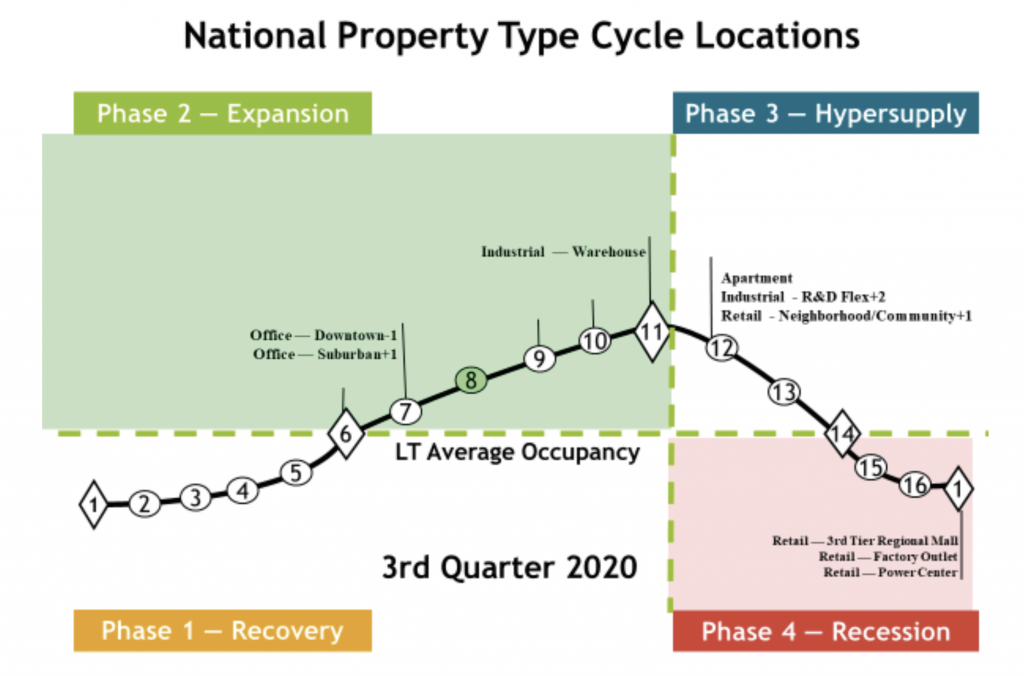
Note: Graph shows relative positions of the sub-property types.
The cycle monitor analyses occupancy movements in five property types in 54 MSAs. Market cycle analysis should enhance investment-decision capabilities for investors and operators. The five property type cycle charts summarise almost 300 individual models that analyse occupancy levels and rental growth rates to provide the foundation for long-term investment success. Commercial real estate markets are cyclical due to the lagged relationship between demand and supply for physical space. The long-term occupancy average is different for each market and each property type. Long-term occupancy average is a key factor in determining rental growth rates — a key factor that affects commercial real estate income and thus returns.
Market cycle quadrants
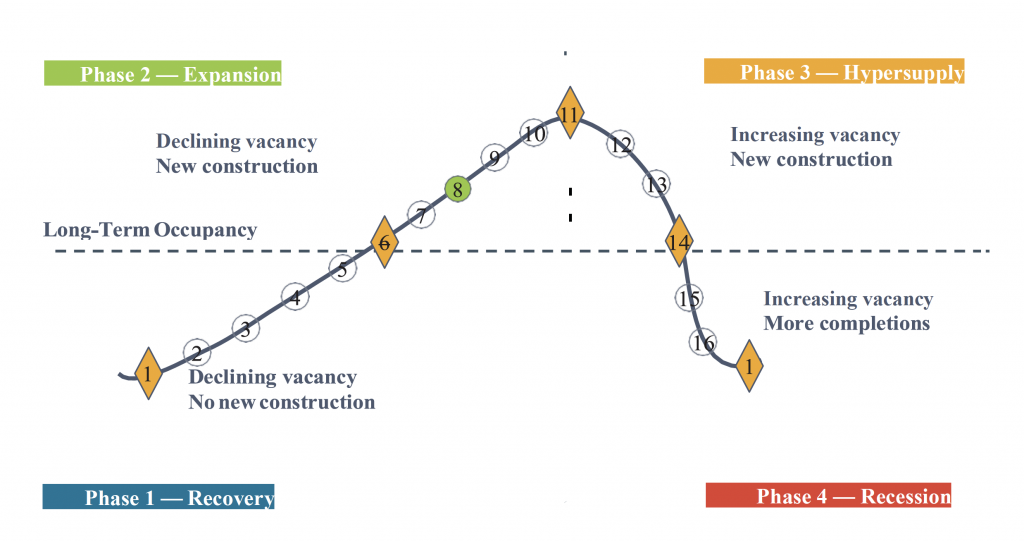
Rental growth rates can be characterised in different parts of the market cycle, as shown below.
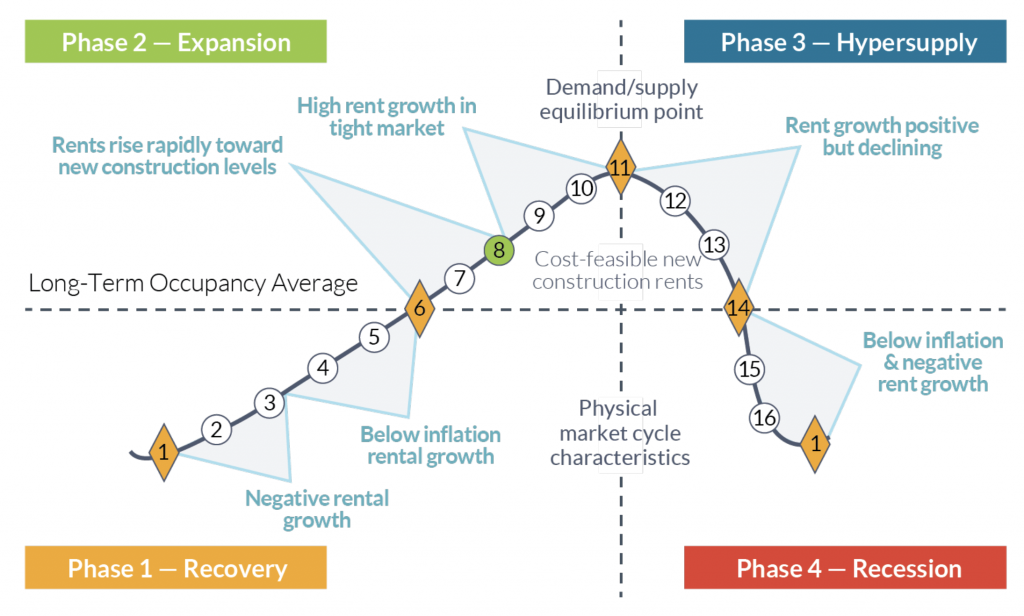
Offices
The national office market occupancy level declined 0.6% in 3Q20 and was down 1.0% year-on-year. This decline pushed the national office occupancy level back down to point #7 on the cycle graph. New supply of 61 million sq. ft plus 50 million sq. ft of sublease (especially in tech markets) created a negative 34 million sq. ft net absorption in 3Q20. Leasing levels were similar to the great recession, as firms delayed new long-term lease decisions and chose short-term renewals/extensions. Everyone is trying to figure out what covid-compliant office space should look like. Office using employment is still 2 million jobs below the 1Q20 peak. Surveys show 85% of employees prefer to be in the office most of the time – leading to the expectation of a full recovery in the long term. Average national rents decreased 0.5% in 3Q20 and produced a 0.1% asking rent increase year-over-year.
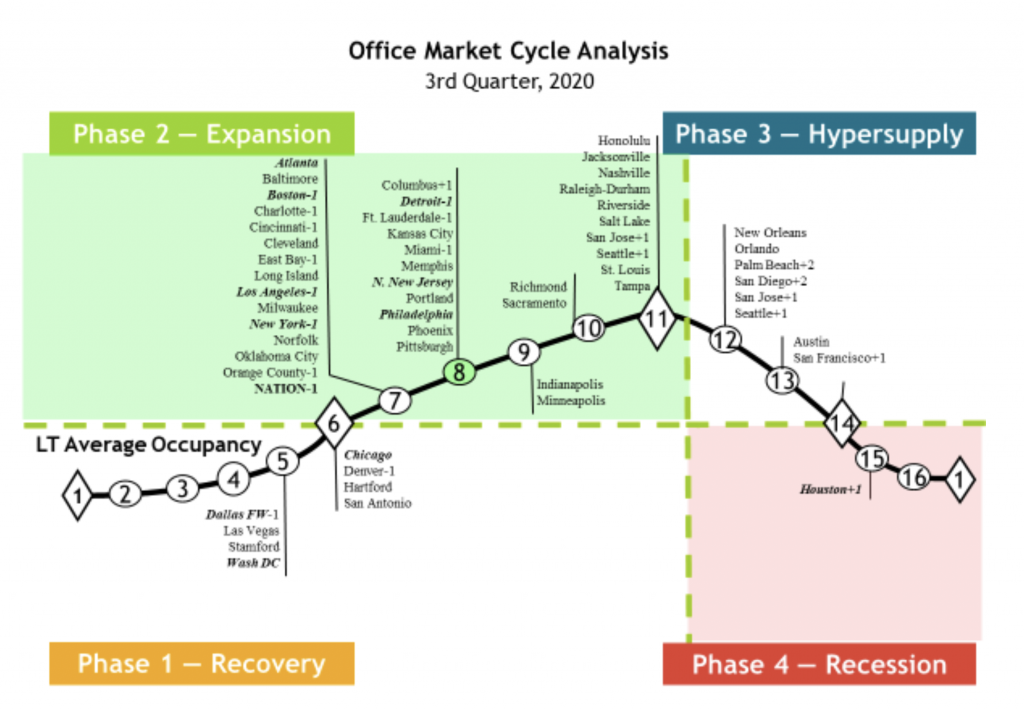
Note: The 11 largest office markets make up 50% of the total square footage of office space we monitor. Thus, the 11 largest office markets are in bold italic type to help distinguish how the weighted national average is affected. Markets that have moved since the previous quarter are now shown with a + or – symbol next to the market name and the number of positions the market has moved is also shown, i.e. +1, +2 or -1, -2. Markets do not always go through smooth forward-cycle movements and can regress or move backward in their cycle position when occupancy levels reverse their usual direction. This can happen when the marginal rate of change in demand increases (or declines) faster than originally estimated or if supply growth is stronger (or weaker) than originally estimated.
Industrial
Industrial occupancies declined 0.1% in 3Q20 and were down 0.8% year-on-year. This pushed the national occupancy average to point #12 on the cycle graph in the hypersupply phase, with many of the large port markets moving there. Even though leasing hit a record 315 million sq. ft in 3Q20 (30% higher than any previous quarter), strong new supply created a net absorption of 146 million sq. ft. Covid-driven retail e-commerce sales, home improvement and logistics operators have pushed demand for bulk warehouse space while covid killed demand for airport retail and the storage demand for supplying other non-essential retail. Flex industrial is showing weakness. Industrial national average rents increased 0.1% in 3Q20 and increased 0.8% year-over-year.
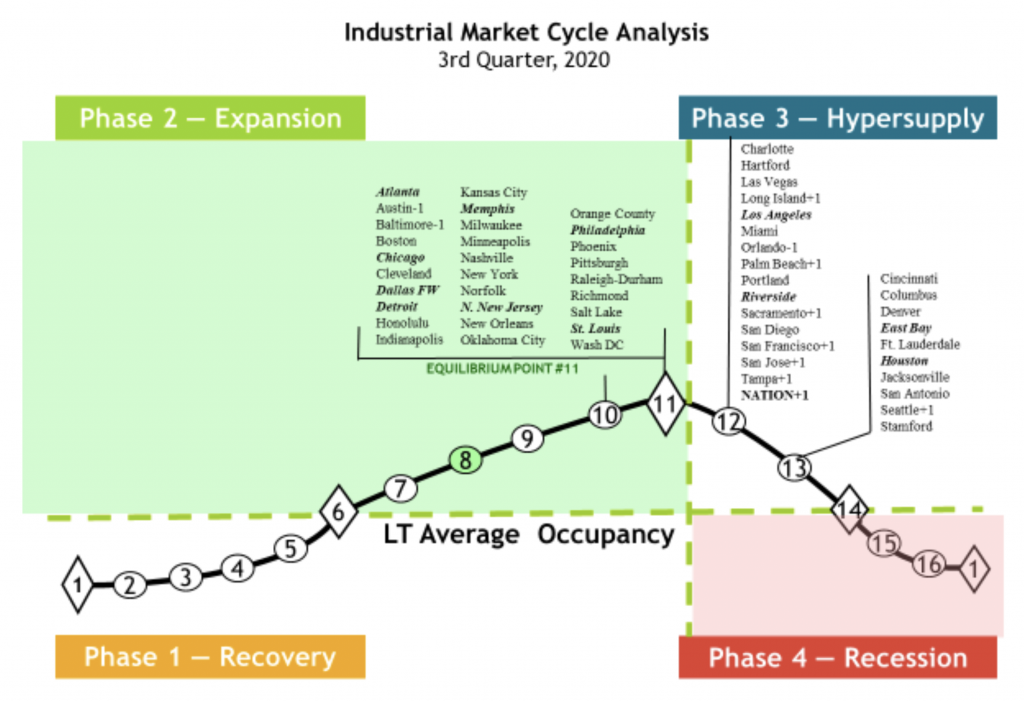
Note: The 12 largest industrial markets make up 50% of the total square footage of industrial space we monitor. Thus, the 12 largest industrial markets are in bold italic type to help distinguish how the weighted national average is affected. Markets that have moved since the previous quarter are now shown with a + or – symbol next to the market name and the number of positions the market has moved is also shown, i.e. +1, +2 or -1, -2. Markets do not always go through smooth forward-cycle movements and can regress or move backward in their cycle position when occupancy levels reverse their usual direction. This can happen when the marginal rate of change in demand increases (or declines) faster than originally estimated or if supply growth is stronger (or weaker) than originally estimated.
Apartments
The national apartment occupancy average declined 0.1% in 3Q20 and was down 0.4% year-on-year. New supply outpaced demand by 25% but leasing was up by 100,000 units in 3Q20 as lockdowns and working from home continued. Urban apartments with small square footage and high amenities lost residents as they moved to larger suburban apartments or rental houses. Suburban occupancy is now 25% higher than urban in most markets. The big question is whether this out-migration trend continues once covid is under control. Younger Millennials who moved home are now moving back to apartments if they have a job. Covid restrictions in place for university dorms have created strong demand for off-campus housing – even when students are taking classes online. Covid is allowing renters who can work anywhere move away from major high-cost cities like San Francisco to lower-cost second-tier markets. Average national apartment rent growth declined -0.1% in 3Q20 and was down 0.4% year-over-year.
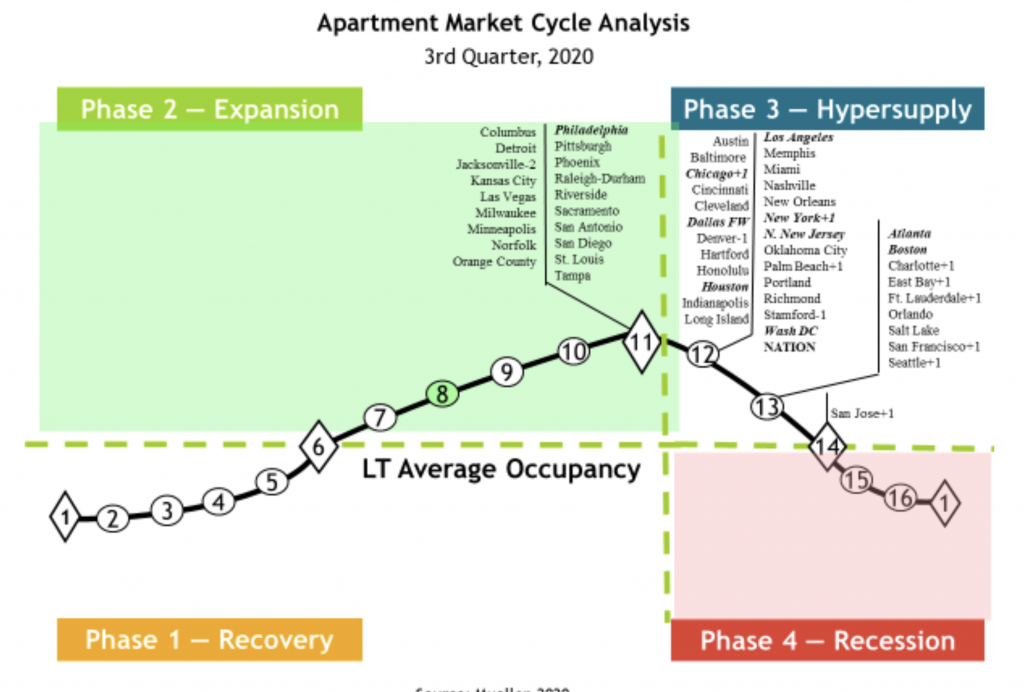
Note: The 10 largest apartment markets make up 50% of the total square footage of multi-family space we monitor. Thus, the 10 largest apartment markets are in bold italic type to help distinguish how the weighted national average is affected. Markets that have moved since the previous quarter are now shown with a + or – symbol next to the market name and the number of positions the market has moved is also shown, i.e. +1, +2 or -1, -2. Markets do not always go through smooth forward-cycle movements and can regress or move backward in their cycle position when occupancy levels reverse their usual direction. This can happen when the marginal rate of change in demand increases (or declines) faster than originally estimated or if supply growth is stronger (or weaker) than originally estimated.
Retail
Retail occupancies were down 0.2% in 3Q20 and were down 0.5% year-on-year. This moved the national occupancy average into the hypersupply phase at point #12 on the cycle graph. Covid policy ‘essential’ retailers are thriving and expanded with 43 million sq. ft of leasing in 3Q20. Triple net lease properties with essential retail tenants were the hottest retail investment in 3Q20 as investors reached for higher yields. Covid-mandated closures and restrictions on non-essential retail are creating more downsizing and bankruptcies. There are also further retail sales declines from personal safety decisions to not go out: malls, strip malls, outlet centres, restaurants and bars being the most affected. National average retail asking rents decreased 0.2% for the quarter and were down 0.5% year-over-year.
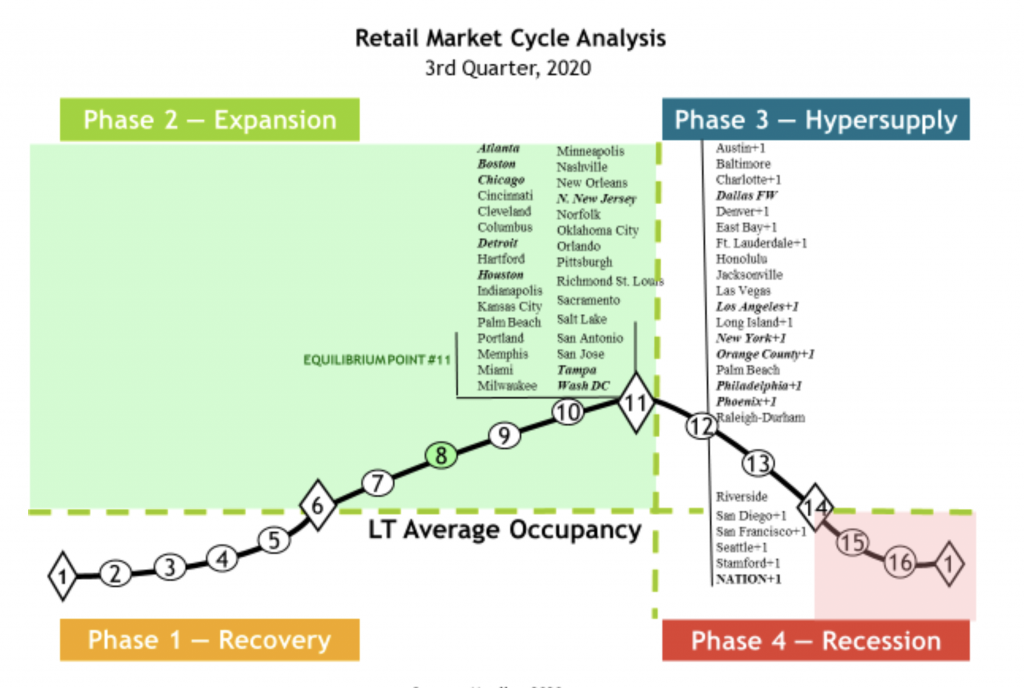
Note: The 14 largest retail markets make up 50% of the total square footage of retail space we monitor. Thus, the 14 largest retail markets are in bold italic type to help distinguish how the weighted national average is affected. Markets that have moved since the previous quarter are now shown with a + or – symbol next to the market name and the number of positions the market has moved is also shown, i.e. +1, +2 or -1, -2. Markets do not always go through smooth forward-cycle movements and can regress or move backward in their cycle position when occupancy levels reverse their usual direction. This can happen when the marginal rate of change in demand increases (or declines) faster than originally estimated or if supply growth is stronger (or weaker) than originally estimated.
Hotels
Hotel occupancy dropped substantially in mid March 2020, with many hotels closing altogether. This drop would put all hotel markets at the bottom of their cycle point, #1 on the cycle chart. Business and convention travel has not resumed in any major way and leisure travel has only returned slowly to a 50% average occupancy level. It may easily be a few years before the leisure industry returns to normal and even more for business.
Data is no longer available from the normal source – thus, hotel coverage is suspended till further notice.
Market cycle analysis – explanation
Supply and demand interaction is important to understand. Starting in Recovery Phase I at the bottom of a cycle (see chart below), the marketplace is in a state of oversupply from either previous new construction or negative demand growth. At this bottom point, occupancy is at its trough. Typically, the market bottom occurs when the excess construction from the previous cycle stops. As the cycle bottom is passed, demand growth begins to slowly absorb the existing oversupply and supply growth is non-existent or very low. As excess space is absorbed, vacancy rates fall, allowing rental rates in the market to stabilise and even begin to increase. As this recovery phase continues, positive expectations about the market allow landlords to increase rents at a slow pace (typically at or below inflation). Eventually, each local market reaches its long-term occupancy average, whereby rental growth is equal to inflation.
In Expansion Phase II, demand growth continues at increasing levels, creating a need for additional space. As vacancy rates fall below the long-term occupancy average, signalling that supply is tightening in the marketplace, rents begin to rise rapidly until they reach a cost-feasible level that allows new construction to commence. In this period of tight supply, rapid rental growth can be experienced, which some observers call ‘rent spikes’. (Some developers may also begin speculative construction in anticipation of cost-feasible rents if they are able to obtain financing.) Once cost-feasible rents are achieved in the marketplace, demand growth is still ahead of supply growth – a lag in providing new space due to the time to construct. Long expansionary periods are possible and many historical real estate cycles show that the overall upcycle is a slow, long-term uphill climb. As long as demand growth rates are higher than supply growth rates, vacancy rates should continue to fall. The cycle peak point is where demand and supply are growing at the same rate or equilibrium. Before equilibrium, demand grows faster than supply; after equilibrium, supply grows faster than demand.
Hypersupply Phase III of the real estate cycle commences after the peak/equilibrium point #11 — where demand growth equals supply growth. Most real estate participants do not recognise this peak/equilibrium’s passing, as occupancy rates are at their highest and well above long-term averages, a strong and tight market. During Phase III, supply growth is higher than demand growth (hypersupply), causing vacancy rates to rise back towards the long-term occupancy average. While there is no painful oversupply during this period, new supply completions compete for tenants in the marketplace. As more space is delivered to the market, rental growth slows. Eventually, market participants realise that the market has turned down and commitments to new construction should slow or stop. If new supply grows faster than demand once the long-term occupancy average is passed, the market falls into Phase IV.
Recession Phase IV begins as the market moves past the long-term occupancy average with high supply growth and low or negative demand growth. The extent of the market down-cycle is determined by the difference (excess) between the market supply growth and demand growth. (Massive oversupply, coupled with negative demand growth that started when the market passed through long-term occupancy average in 1984, sent most US office markets into the largest down-cycle ever experienced.) During Phase IV, landlords realise that they could quickly lose market share if their rental rates are not competitive. As a result, they then lower rents to capture tenants, even if only to cover their buildings’ fixed expenses. Market liquidity is also low or non-existent in this phase, as the bid-ask spread in property prices is too wide. The cycle eventually reaches bottom as new construction and completions cease, or as demand growth turns up and begins to grow at rates higher than that of new supply added to the marketplace.
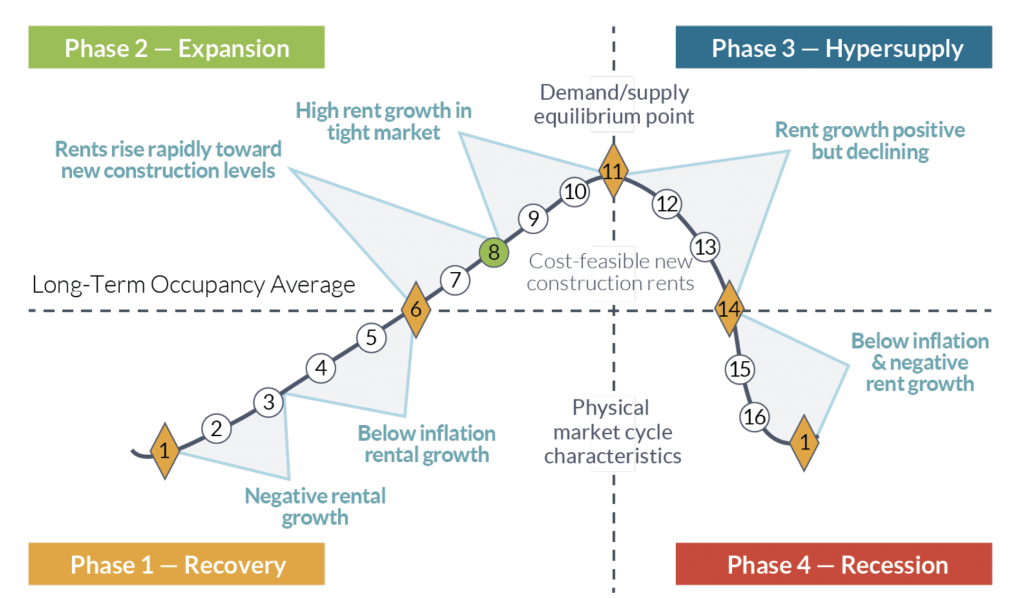
This research currently monitors five property types in 54 major markets. We gather data from numerous sources to evaluate and forecast market movements. The market cycle model we developed looks at the interaction of supply and demand to estimate future vacancy and rental rates. Our individual market models are combined to create a national average model for all US markets. This model examines the current cycle locations for each property type and can be used for asset allocation and acquisition decisions.
Contact: glenn.mueller@du.edu







